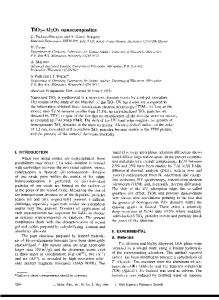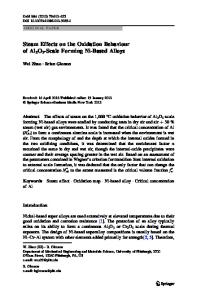Al 2 O 3 scale development on iron aluminides
- PDF / 474,582 Bytes
- 11 Pages / 612 x 792 pts (letter) Page_size
- 97 Downloads / 344 Views
K. Thaidigsmann Department of Material Sciences and Surface Technology, University for Applied Science, 73430 Aalen, Germany
J. Ager and P.Y. Houa) Materials Sciences Division, Lawrence Berkeley National Laboratory, Berkeley, California 94720 (Received 10 November 2005; accepted 23 February 2006)
The structure and phase of the Al2O3 scale that forms on an Fe3Al-based alloy Fe-28Al-5Cr (at.%) was investigated by transmission electron microscopy and photoluminescence spectroscopy. Oxidation was performed at 900 °C and 1000 °C for up to 190 min. Transmission electron microscopy revealed that single-layer scales were formed after short oxidation times. Electron diffraction was used to show that the scales are composed of nanoscale crystallites of the , ␥, and ␣ phases of alumina. Band-like structure was observed extending along three 120°-separated directions within the surface plane. Textured and ␥ grains were the main components of the bands, whereas mixed ␣ and transient phases were found between the bands. Extended oxidation produced a double-layered scale structure with a continuous ␣ layer at the scale/alloy interface and a ␥/ layer at the gas surface. The mechanism for the formation of Al2O3 scales on iron aluminide alloys is discussed and compared with that for nickel aluminide alloys.
I. INTRODUCTION
A slow-growing, adherent, and chemically stable oxide layer is an essential component of any metal alloy that is designed for high-temperature operation. For most Al-containing, high-temperature alloys and coatings, including, for example, Ni-based superalloys, Ni or Fe aluminides, and FeCrAl alloys, this layer is composed of Al2O3. The aluminides, being high-temperature intermetallics, have been vigorously pursued since the early 1950s for aerospace and power-generation industries because of their high melting points and low densities. Although their brittleness, especially at ambient temperatures, and low strengths at high temperatures have greatly hindered their applicability, NiAl has been successfully used as an oxidation-resistant coating, and Ni3Al- and Fe3Al-based materials are being commercialized for applications such as industrial heat treatment equipment and hot gas filters.1 The development and evolution of Al2O3 scales on NiAl has been studied extensively by transmission electron microscopy (TEM), but there are comparatively fewer studies of this process for FeAl.
a)
Address all correspondence to this author. e-mail: [email protected] DOI: 10.1557/JMR.2006.0172 J. Mater. Res., Vol. 21, No. 6, Jun 2006
http://journals.cambridge.org
Downloaded: 18 Mar 2015
Past works on the scale development on NiAl and FeAl are summarized below. On -NiAl, Doychak et al.2 studied the oxidation of (001), (012), (011), and (111) single crystals containing 0.1wt% Zr using plan-view TEM specimens. The major oxide phase was identified as -Al2O3 within 10 h at 800 °C and 0.1 h at 1100 °C, although some ␦ phase may be present between 0.1 and 1 h at 800 °C. On all alloy orientations, the scale formed epitaxially, wh
Data Loading...











